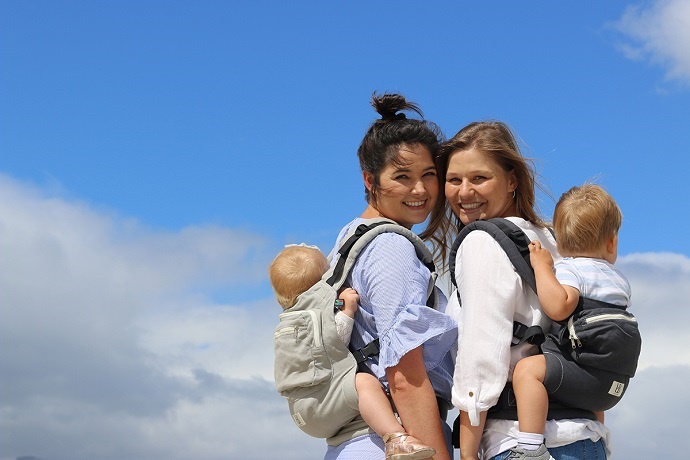
Babywearing is a novel term, but an age-old concept. For decades, parents have been holding their babies close to them. Now with advanced technology, this wonderfully natural way to help ease both parent and baby into this new life becomes a little simpler.
We recently chatted to Shannon McLaughlin, founder of Ubuntu Baba, who answered some questions on the science behind babywearing and how it really does help smooth the transition into parenthood.
Also see:The Ubuntu Baba Mama talks family, work and the one thing she’d change for women everywhere if she could
Q: Where did the idea of babywearing originate?
A: "The ancient art of babywearing has been practised for centuries by indigenous communities all over the world. Not only does it keep baby calm and happy, it allows mom or dad to be hands-free for a few hours while baby is happily asleep against the body. It has only recently become popular in modern society, due to the influence of advocates of attachment parenting.
One study found that if the father held their new baby against his chest, skin-to-skin, while the mother recovered from her C-section, their newborn would sleep better, cry less and take more easily to breastfeeding.
It’s also a convenient form of baby transport and parents will often use it when travelling with children, hiking or walking long distances, well into the toddler years."
Q: Does babywearing spoil the infant or create bad habits by holding them for long periods?
A: "No, there is no such thing as spoiling your baby – this is an outdated old wives tale. Your baby needs as much love and physical touch as possible to help them feel comfortable in their new environment."
Q: What is the NINO period?
A: "In babywearing, the NINO period stands for nine months in, nine months out. It’s the most important stage for emotional development, when your baby needs to feel the safety of being held close against your chest and the sound of your heartbeat will almost always calm them down. Babies often go through periods of being overstimulated and struggling to fall asleep so we designed our Stage 1 carrier to create more of a hugging feeling around baby, which mimics the feeling of being held snugly in the womb and helps to calm them down so they can fall asleep quickly."
Also see: WATCH: This meteorologist wore her son on her back while doing the weather forecast
Q: What are your thoughts regarding the M-position baby carriers create?
A: "The ergonomic M position is the natural froggy position that your baby will assume if you hold them up onto your chest. There is absolutely no over-stretching of the hips involved as the seat width of a well-designed carrier should be fully adjustable to suit the width of your baby’s hips."
Are you considering babywearing? Share your questions with us and we could publish your email. Anonymous contributions are welcome.
Q: Can babywearing help with gas, colic or reflux?
A: "Absolutely! Keeping your baby upright after a feed has been attributed to decreasing the effects of reflux by helping to stop the acid refluxing and your baby vomiting. As soon as your baby has settled after a feed you can put them in the carrier which will keep them in an upright position. The simple natural movement of walking with your baby in a carrier will help calm and settle them."
Q: Can wearing your baby promote a more nurturing nature in Moms?
A: "There’s a lot of pressure on new parents to bond with their baby from the start, but that quite often doesn’t just happen immediately. Moms can be left feeling very vulnerable after a traumatic birth experience and may struggle to bond with their baby immediately. Babywearing can really help in these cases.
If we take the traumatic birth situation (which is more common than we’re led to believe), a mother’s body can be really sore and bruised and she often doesn’t have the physical strength for weeks that she is used to, so carrying a baby in arms can add to that exhaustion. A baby carrier allows her to be hands-free yet still keep her baby close to her heart. It’s a comforting experience for both mom and baby."
Also see: Parents with Prams parking: when should you make way for the next generation
Q: Can babywearing help with post-natal depression?
A: "A new mom might feel very scared to leave the house with her new baby for fear that the baby might get upset or need to breastfeed in public. These fears, when not addressed or overcome naturally, can lead to a deep depression – babywearing can help a mom overcome these fears and give her the confidence to leave the house alone with her baby, as well as breastfeed in the carrier without anyone even noticing.
Oxytocin is released during long periods of positive physical contact with your baby, which can reduce anxiety and help with the symptoms of post-natal depression. Moms can create healthy attachments to their babies and feel less overwhelmed or stressed – especially having two free hands and a snuggly baby."
Chat back:
Are you a babywearing parent?
Share your experience with us and we could publish it. Anonymous contributions are welcome.




 Publications
Publications
 Partners
Partners















